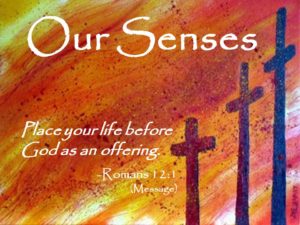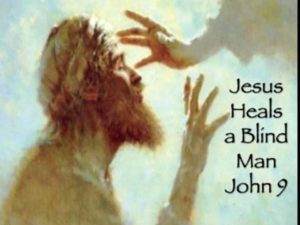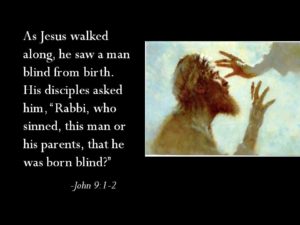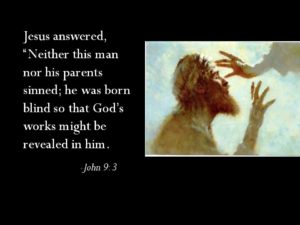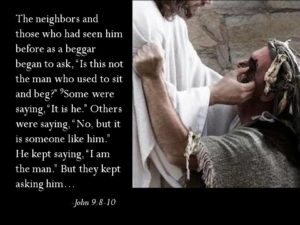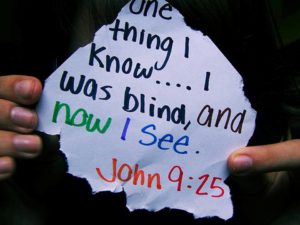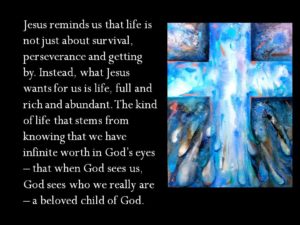When you look out on the world, at the people around you, what do you see? In the 9th chapter of John, we read the story of the man who was born blind who is given the gift of sight. This story makes me wonder about the difference between what we see and what God sees.
So much of our experience of life has to do with our senses – sight, hearing, touch, smell and taste. We interpret life coming at us through these every day – so it makes sense, pardon the pun, that our faith, our understanding of God’s presence in the world and in our lives would also come to us through seeing and hearing – through touch and smell and taste.
This morning we hear a portion of the story of Jesus’ encounter with a man who we hear has “been blind from birth”.
As Jesus and his disciples walk by, “His disciples asked Jesus, “’Rabbi, who sinned, this man or his parents, that he was born blind?’” (John 9:2).
This is a really important question on a couple of different levels – and Jesus addresses them. But, before we even get to that, I actually have to say that I find it disturbing that the disciples would take the reality of this man’s life and turn it into a theological abstract, and probably within ear shot to boot.
We might imagine this man, on a daily basis, spreading his cloak out next to him on the side of the road, hoping and praying that those passing by would drop a few coins to help him survive. That was likely his reality.
And the disciples, with their question, pile on and deepen the perception of this man and his life as being defined by and reduced to his blindness alone.
And so it is also interesting to recognize the lack of “seeing” that the disciples display as they pass by in judgment, asking this question of Jesus.
Jesus’ quickly makes up for this theological query with a two-pronged response. First, “Jesus answered, “Neither this man nor his parents sinned; he was born blind so that God’s works might be revealed in him”. (John 9:3)
But then Jesus does something remarkable, he stops, kneels down next to the man, he then “spat on the ground and made mud with the saliva and spread the mud on the man’s eyes, saying to him, “Go, wash in the pool of Siloam” (which means Sent). (John 9:6-7).
Just another example of Jesus meeting people where they are – meeting them in the reality of their lives – an important teaching and modeling for the disciples and for us too.
We hear simply that the man “went and washed and came back able to see”.
This was great news for the man – and for his family too. But there is something else here that is really kind of dismaying – listen again to these verses:
The neighbors and those who had seen him before as a beggar began to ask, “Is this not the man who used to sit and beg?” Some were saying, “It is he.” Others were saying, “No, but it is someone like him.” He kept saying, “I am the man.” But they kept asking him, “Then how were your eyes opened?” (John 9:8-10)
Had the man become so invisible to the community that they now didn’t recognize him? Or was his transformation just that profound?
He had sat and begged there daily, and every day they all walked by him, but now he was different, they couldn’t be sure of who he was — others went to get his parents for an official identification. For whatever reason, even though he was the one that was blind, it seems that they’d never really looked at him – never really noticed his face.
I think about how often I walk past people and never really look at them or acknowledge their presence either – and I’m not just talking about walking by homeless folks on the sidewalk in the Loop – but in general, at the store, in passing through the various places of life. There is value in seeing. And seeing not only with our own eyes – but also imagining what it is that God sees.
There is a story of a homeless man who was sitting across the street from an artist’s studio. The artist saw him and thought he would make an interesting portrait study so from a distance he painted the defeated man whose shoulders drooped, and whose eyes were downcast and sad. When he was finished, he took the portrait over to the man so he could look at it.
“Who is that?” the man questioned. The painting bore a slight resemblance to himself, but in the painting before him he saw a person of dignity, with squared shoulders and bright uplifted eyes, almost handsome! He asked the artist, “Is that me? I don’t look like that.” But the artist replied, “but that is the person I see in you.”
Seeing as God sees. Seeing value in the other – seeing the light of God in our neighbors – our brothers and sisters – the strangers we encounter along the way.
Imagining what God sees in one another is important and instructive, but I also don’t want to lose sight of the awesomeness of the formerly blind man’s transformation.
While everyone else, the neighbors, the Pharisees and even the disciples are focused on how or why this could have happened, or the legality of healing on the Sabbath or if the power was from God or from somewhere else – while all this is going on, the formerly blind man does not shy away from this gift he has been given.
He doesn’t just receive the gift of sight to be enjoyed as his own possession. Instead, he uses it as a means of encouraging others to see as well. He repeatedly points people toward the reality of the event that occurred and whose hands did the healing. He meets his neighbors’ amazement by reporting “just the facts.”
We hear this, in the midst of his second interrogation by the Pharisees, they accuse Jesus of being a sinner and they want the man to corroborate that fact, to which the man answers: “I do not know whether he is a sinner. One thing I do know, that though I was blind, now I see.” (John 9:25)
The man who was formerly blind may have just received his physical sight, but his spiritual in-sight is already keen. He will not let them off the hook – as he continues to praise God and tell anyone who will listen what has happened in his life that day.
When Jesus comes into our lives, things change. And that sounds good, until we realize that change is always disruptive. We never learn the man’s name, but his story reverberates over the next chapters of John. In the disruption of his life, I would like to know what he did the next day. How was his life better or worse or different? What happened to him?
There is so much in this story – so many levels of meaning – we could spend weeks in study on this chapter alone – at the core of this story however, Jesus reminds us that people are not theological abstracts to be queried over – we, and all people, are not statistics or case studies or boxes to be checked – we are human beings worthy of respect, worthy of time and connection and dignity.
Jesus reminds us that life is not just about survival, perseverance and getting by. Instead, what Jesus wants for us is life, full and rich and abundant. The kind of life that stems from knowing that we have infinite worth in God’s eyes – that when God sees us, God sees who we really are – a beloved child of God.
Let us pray: Gracious God, you have created us all in your image, giving each of us a unique calling to love and serve you. Open our hearts and minds to truly see the people you send our way. Show us how to support one another, and teach us how to live as the body of Christ, how to lead and be led, how to love and be loved. In Jesus’ name. Amen.
Rev. John Berg
Gloria Dei Lutheran Church
Northbrook, IL
Resources consulted:
- “Dealing with the Day”, Alyce M. McKenzie, March 23, 2014
- “Another Perspective”, Brett Blair, www.Sermons.com Adapted from New Vision in Christ, by Rev. Michael J. Fish
- “Identity Theft, Part 2”, David Lose, March 25, 2014

